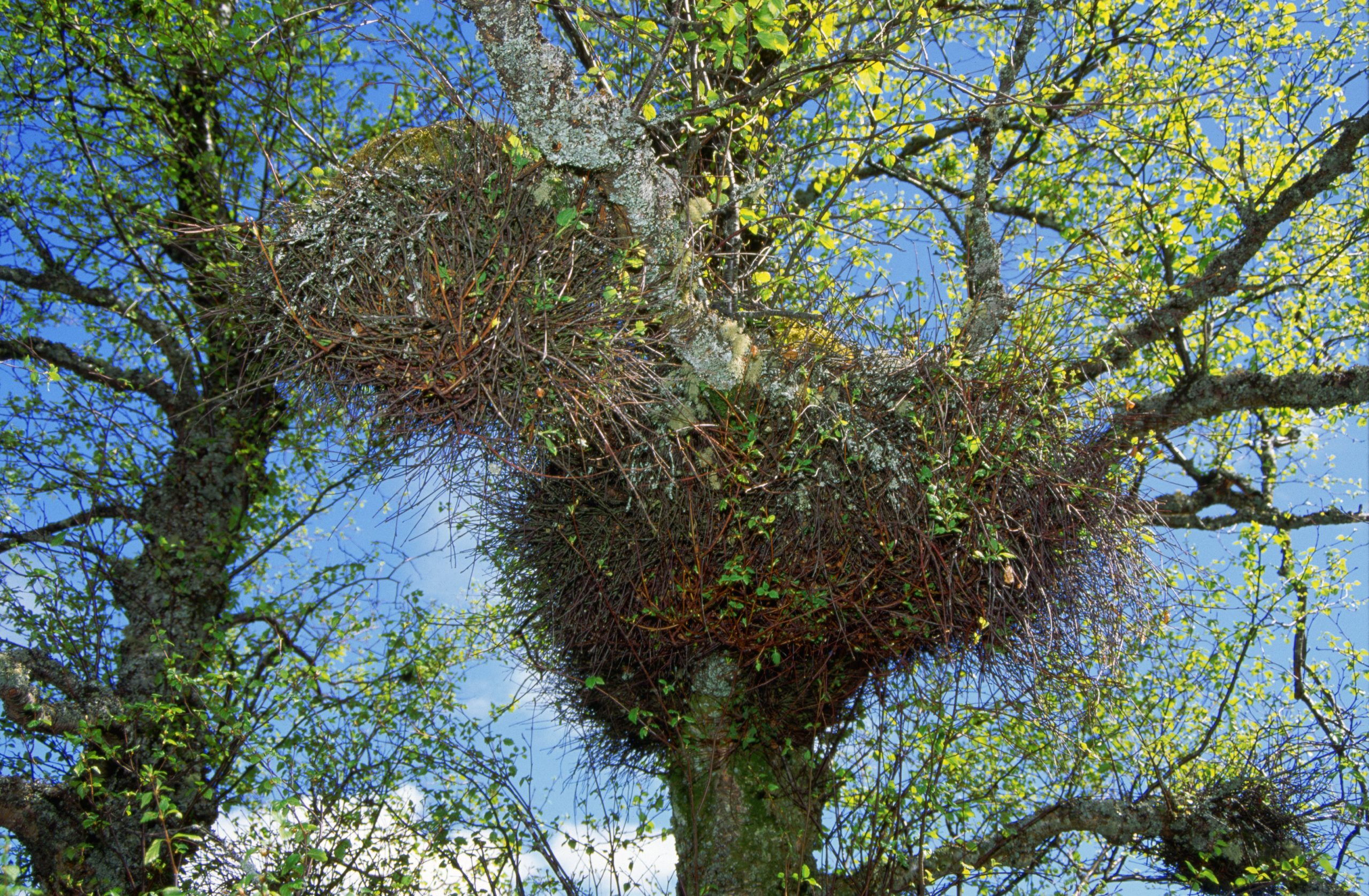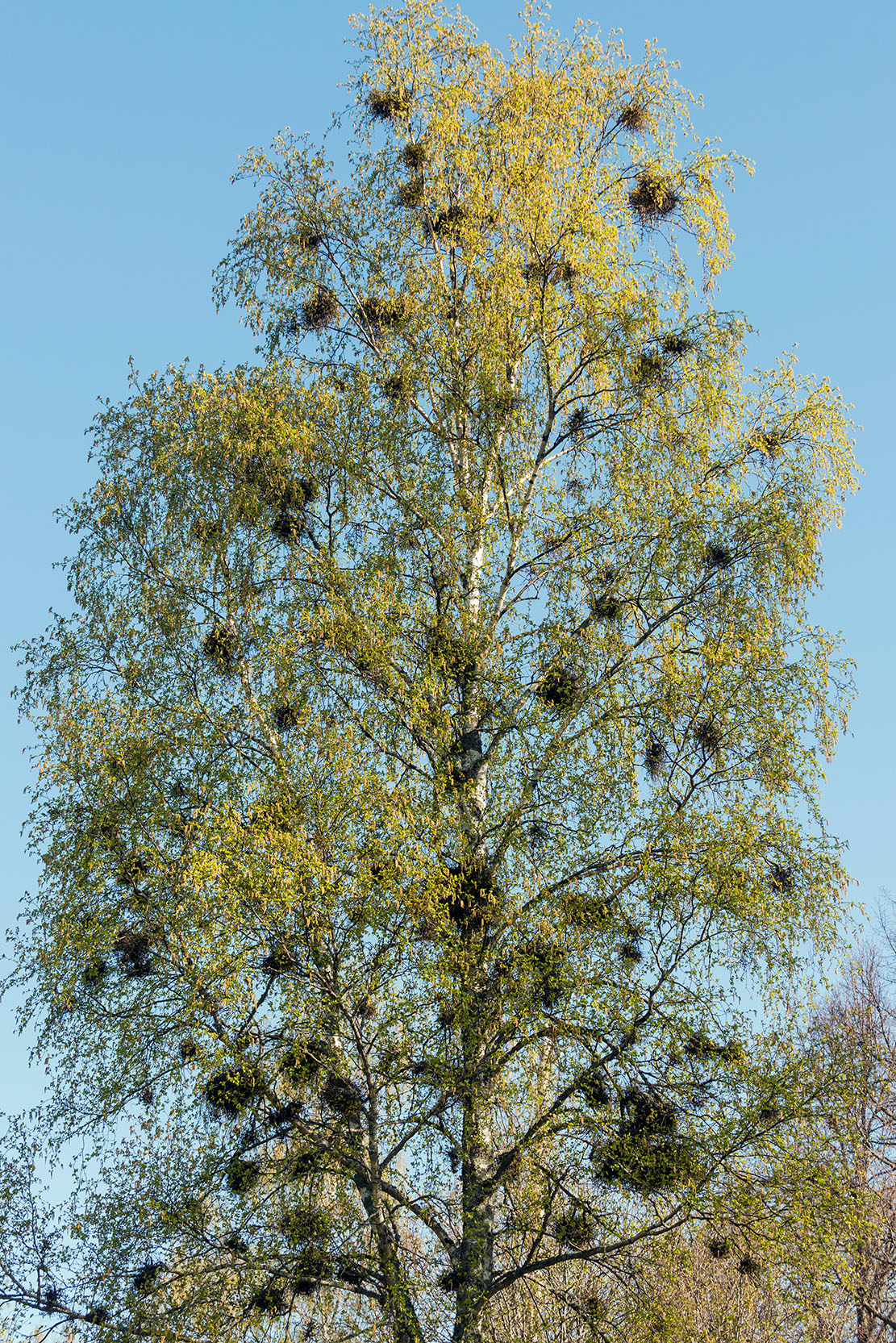Curious Questions: How does Witches' Broom form in trees?
Martin Fone looks into one of the most curious — and curiously named — natural phenomena visible on a country walk in Britain.


A winter woodland walk, an opportunity to admire the deciduous trees’ skeletal frames with their filigree of twigs against the lowering sky, to hear the creaking of the boughs in the wind. Something about a Silver Birch (Betula pendula) catches the eye, five dense, ball-like masses of stunted twigs hanging from its branches. The mind runs riot. Creations of an industrious mammal or home to an unusually large bird? The truth more prosaic; a woody deformity known as Witches’ broom.
While many woody plant species, whether deciduous or evergreen, are prone to developing Witches’ brooms, in Britain they are usually seen on birch. Some trees have one, others several, and they can form anywhere from the lower parts of the tree to the uppermost branches. They also vary in size, some barely detectible with the naked eye, others large and easily seen, even in the summer.
Witches’ brooms have an uncanny resemblance to a besom, a broom made from a bundle of twigs. As well as for sweeping floors, besoms, at least in popular imagination, were used by witches to fly around on, the first depiction of which appeared in marginalia of a 1451 edition of Martin Le Franc’s Le Champion des Dames. It was an easy leap for the mediaeval mind to believe that these masses of twiggy growths were deposited by witches in the first place, especially in the absence of a more rational explanation.
In mediaeval Germany they were called ‘Hexenbesen’, which, translated directly into English, gives us Witches’ broom as well as the verb ‘to hex’, to bewitch, and ‘besom’. Witches also used them as stopping places or nests (‘Hexennester’), as did elves, hobgoblins, and mares. Mares were spirits whose particular trait was to sit on the chest of a sleeper and cause them to have bad dreams, from which we have derived the word nightmare. ‘Mahrnester’ or mare’s nest is the alternative German word for a Witches’ broom.
How is witches' broom formed?
Unlike Mistletoe, with which they are often confused, Witches’ brooms are not parasites stealing the water and nutrients of their unfortunate hosts but forms of abnormal growth in the tree’s cells. When growing normally, a tree or shrub will exhibit what botanists call apical dominance, the plant producing a hormone, auxin, which slows the growth of the lateral or side stems and allows the central or apical stem to grow taller and compete for light.
Organisms such as fungi, mites, aphids, ironically, Mistletoe, and in British birches the ascomycete fungus, Taphrina betulina, can upset this process by inducing the tree to create cytokinin, a form of phytohormone, which interferes with its ability to regulate bud growth in a certain area. Green buds first appear on the tree and can often remain as buds for several years until they grow into shortened branches or slender twigs. Each of these will then potentially produce more small buds which will either fall off or themselves sprout into yet more twigs. Over time the tree will have produced a bundle of tightly packed twigs in that area.
Some defect in the tree, often caused by scarring or clumsy pruning, offers the micro-organisms the opportunity to enter the tree and trigger the formation of brooms. They rarely harm the tree, just reducing flowering in the affected area of the tree. They also offer a haven for other organisms, although not to witches, several species of moth reliant upon certain types of Witches’ brooms for food and shelter for their larvae.
Exquisite houses, the beauty of Nature, and how to get the most from your life, straight to your inbox.

Genetic mutations in the buds of the branches can also cause a broom to form, although, normally, there will only be one to a tree. Unlike those caused by living organisms, these can be harmful, diverting energy from the rest of the tree and reducing its strength and ability to withstand extreme weather and disease.
Even more deadly is Witches’ broom disease, endemic to South America and the Caribbean, and first reported in 1785 by the explorer, Alexandre Rodrigues, in the Brazilian Amazon basin. When it spread from the Amazon basin to the state of Bahia in 1989, Brazil was the world’s second grower of cocoa beans, producing around 400,000 metric tonnes of beans a year. By 2000, its harvest had fallen by three-quarters, wiping out many cocoa farms, causing economic hardship and environmental disaster as dispossessed farmers cut down rainforests to make room for livestock and arable crops.
The cause of this deadly outbreak was a fungus, Moniliophthora perniciosa, which stimulated the plant to produce cytokinin, causing the pods to wither and die and diverting its dwindling energy to sprout bundles of stunted twigs. It also attacked the roots which meant that the traditional method of removing infected branches was less effective, a discovery at the turn of this century that has allowed scientists to develop more effective strategies to deal with the disease.
Pieces of Witches’ brooms that have developed from a genetic mutation have been rooted or grafted to produce dwarf or miniature plants. Many miniatures, especially conifers, which are commonly found in gardens almost certainly started from a broom, a practice which began almost 250 years ago.
The earliest named miniature conifer was the bee-hive shaped Picea abies ‘Clanbrassiliana’, a dwarf form of Norway spruce, first found around 1780 on the Moira Estate near Belfast. Lord Clanbrassil transferred to his country residence in Tollymore, Co Down, where the mother plant flourishes to this day. The Lodigges Nursery of Hackney introduced the species to the nursery trade in the 1820s.
Another early conifer cultivar was Picea abies ‘Pygmaea’, which began appearing in arboretums and exotic gardens from around 1800. Two were grown in what was reputedly the world’s first rock garden at Lamport Hall in Northamptonshire from 1820, but sadly they have now been removed.
In the Heather Garden at Savill in Windsor Great Park there is a splendid specimen of Pinus sylvestris ‘Beuvronensis’, a dwarf Scotch pine, that now stands over 17-feet high. Its height suggests that dwarf or slow conifer cultivars derived from Witches’ brooms grow faster over time as the hormones suppressing growth of the leading shoot become less effective.
Intriguingly, the Little Gem spruce (Picea abies ‘Little Gem’) came from a Witches’ broom taken from a Bird’s Nest spruce (Picea abies ‘Nidiformis’), which had earlier been cultivated from a Witches’ broom produced by a Norway spruce.
The usual way to get hold of a Witches’ broom is to climb the tree and carefully cut it down. However, Chinquapin, the Newsletter of the Appalachian Botanical Society [pdf link] (Winter 2012), revealed that in the States ‘most often a shotgun is used’, a procedure that leads to a shower of broken pieces raining to the ground. As no roots will have survived the shock, small portions of the broom, scions, are grafted on to rootstock of the same variety.
Witches’ brooms have also been used to make brooms, the most recherché of research published in the Journal of Ethnobiology and Ethnomedicine (May 2007) revealed. Of the 108 plants traditionally used to make brooms in Bulgaria, Italy, Macedonia, and Romania, it reported, two were taxa fungi that produce ‘the so-called Witches’ broom’, a curious circularity.
There is more to Witches’ broom than meets the eye.
After graduating in Classics from Trinity College Cambridge and a 38 year career in the financial services sector in the City of London, Martin Fone started blogging and writing on a freelance basis as he slipped into retirement. He has developed a fearless passion for investigating the quirks and oddities of life and discovering the answers to questions most of us never even think to ask. A voracious reader, a keen but distinctly amateur gardener, and a gin enthusiast, Martin lives with his wife in Surrey. He has written five books, the latest of which is More Curious Questions.
